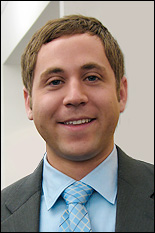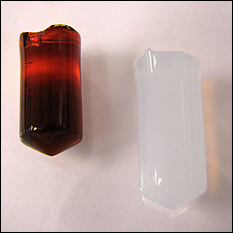Molecularly Imprinted Polymers for Viral Diagnostics
 Dan Janiak received his Ph.D. in May 2009. Before graduating, the blood-filtering technology described in this story received the Outstanding Invention of the Year in the Life Sciences category of the University's Office of Technology and Commercialization's annual awards. Another MIPs-based invention he developed with Professor Peter Kofinas took first place in the Faculty and Graduate Student Division of the Maryland Technology Enterprise Institute's 2008 $50K Business Plan Competition. He currently works for DFJ Mercury, a seed-stage venture capital firm based in Houston, Tx.
Dan Janiak received his Ph.D. in May 2009. Before graduating, the blood-filtering technology described in this story received the Outstanding Invention of the Year in the Life Sciences category of the University's Office of Technology and Commercialization's annual awards. Another MIPs-based invention he developed with Professor Peter Kofinas took first place in the Faculty and Graduate Student Division of the Maryland Technology Enterprise Institute's 2008 $50K Business Plan Competition. He currently works for DFJ Mercury, a seed-stage venture capital firm based in Houston, Tx.
In the not-so-distant future, you may find yourself less likely to suffer from a viral infection thanks to more plentiful vaccines, have it treated more effectively if you do get one, or possibly even have viruses filtered right out of your blood. During his time at the Clark School, Materials Science and Engineering (MSE) graduate student Dan Janiak iworked to make that happen, and a proposal outlining his solution, "VIPER: Solutions for Viral Diagnostics," earned him the 2007 Fischell Fellowship in Biomedical Engineering.
Janiak, who worked in the Functional Macromolecular Laboratory and is advised by its director, Fischell Department of Bioengineering Professor Peter Kofinas (who is also appointed to MSE as an affiliate faculty member), engineered polymers capable of recognizing and capturing specific peptides, proteins, and larger macromolecular structures‚in his case, viruses. The polymers took the form of molecularly imprinted hydrogels, highly-absorbent, water-insoluble substances that, he explains with a laugh, "look like pieces of Jell-O." The gels were imprinted with a specific virus' shape. When molecules of that target virus were filtered though the gels, they‚ and only they‚ fit snugly into the imprint cavities and were trapped.
In diagnostic and treatment applications, the hydrogels could be used in blood tests as a means of detecting viral infection, and in hemodialysis, a process in which unwanted molecules are removed from the blood‚ probably best known as the waste-filtering treatment given to patients suffering from kidney failure. The hydrogels Janiak developed could be used in new kinds of hemodialysis in which they would serve as tailor-made filters, catching blood borne viruses like HIV. Cleaned blood would be then returned to the body. While filtering cannot cure a viral illness, it can help patients feel better by removing viruses as they are produced by infected cells. This new technology could be integrated into existing medical equipment at a low cost to hospitals and other healthcare facilities.
 Janiak's work could also benefit vaccine production. When a vaccine, which is made from inactive virus particles, is produced, the particles that are needed must be separated from the biomass in which they reside. Currently, this is a time-consuming and difficult process. According to Janiak, the biomass could be filtered through an imprinted hydrogel, which would trap only what is needed to make the vaccine while letting debris pass through. For this portion of his research, he tested the effectiveness of the hydrogels on Human Parvovirus B19, a fever-and-rash illness that typically affects babies, and for which there is currently no vaccine. He took advantage of the Functional Macromolecular Laboratory's relationship with the National Institutes of Health, using their facilities to cultivate the parvovirus capsids‚ non-infectious shells he needed for his work.
Janiak's work could also benefit vaccine production. When a vaccine, which is made from inactive virus particles, is produced, the particles that are needed must be separated from the biomass in which they reside. Currently, this is a time-consuming and difficult process. According to Janiak, the biomass could be filtered through an imprinted hydrogel, which would trap only what is needed to make the vaccine while letting debris pass through. For this portion of his research, he tested the effectiveness of the hydrogels on Human Parvovirus B19, a fever-and-rash illness that typically affects babies, and for which there is currently no vaccine. He took advantage of the Functional Macromolecular Laboratory's relationship with the National Institutes of Health, using their facilities to cultivate the parvovirus capsids‚ non-infectious shells he needed for his work.
When he applied for the Fischell Fellowship, Janiak took his ideas a step further by explaining how his hydrogels could be incorporated into marketable medical devices and used to improve existing procedures. The entrepreneurial nature of the Fellowship prompted him to "think outside the lab" and about the potential future of his work: "[The application process] is inspiring and it makes you appreciate what people do to take technology from the lab to industry. It's something I'm a lot more interested in now." He has even received business and product development advice from fellowship sponsor and alumnus Dr. Robert E. Fischell, the inventor of numerous biomedical devices.
The most rewarding outcome of his work, Janiak says, would be to see his polymers and techniques used in an industrial research setting to aid in vaccine development. "Any time you start a project you want to have some commercial application for it, and in our case I think vaccine purification is one of best ones possible."
Janiak originally intended to have a career in computers. He came to Maryland's computer science program as a freshman in 2000, only to realize it wasn't where his heart was. "When I was looking for a new major," he says, "I met [MSE Assistant Director of Student Services] Kathleen Hart and [MSE Associate Professor Isabel] Lloyd, and they totally convinced me to become a materials scientist. [MSE] is a nice blend of chemistry and physics, which were two things I was interested in. They said it was the best major in the world, and I believed them. I still do."
Asked about the best part of his Clark School experience, Janiak answers without hesitation: "My research group. I think we have the best one on campus. We all get along so well and we spend time with each other and socialize outside of the lab."
Janiak also appreciated the personal connections Maryland cultivates between faculty and students. "I know all of the professors in the department and I feel comfortable here. There are a lot pf people doing really good research. You have a chance to get a good advisor and get help if you need it." He also benefitted from the strong relationship between his home department, MSE, and the Fischell Department of Bioengineering. PRofessor Peter Kofinas' and MSE Professor and Chair Robert M. Briber's research groups held joint meetings, an uncommon arrangement‚ especially in a cross-department context‚ but one Janiak feels strengthened everyone's work: "I [was able to] go to [Dr. Briber] for advice just like I [went] to Dr. Kofinas. [The groups] mesh[ed] well, because Dr. Kofinas is more of a polymer engineer and polymer scientist focusing on applications, while Dr. Briber does a lot of polymer characterization and is a physicist, so their skill sets [were] complimentary."
Janiak has some advice for undergraduates considering pursuing a graduate degree in materials science and engineering. "The knowledge you get out of courses in kinetics, solid-state physics, thermodynamics, and polymer synthesis are really important to any materials research and development. Electives are more exciting because that's where you work on what you're most interested in, but eventually it all relates back to those fundamental classes."
Top